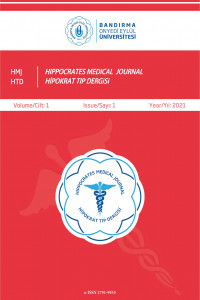Pseudo-Meigs Sendromu ile Başvuran Struma Ovarii: Bir Olgu Sunumu ve Literatürün Gözden Geçirilmesi
Pseudo-Meigs Sendromu, Asit, Hidrotoraks
Struma Ovarii Presented With Pseudo-Meigs’ Syndrome: A CaseReport and Review of The Literature
Pseudo-Meigs’ Syndrome, Ascites, Hydrothorax,
___
- Md Nor NB, Kusumoto T, Inoue S, Nakamura K, Seki N, Hongo A, et al. Three cases of struma ovarii underwent laparoscopic surgery with definite preoperative diagnosis. Acta Med Okayama 2013; 67:191–195.
- Loizzi V, Cormio G, Resta L, Fattizzi N, Vicino M, Selvaggi L Pseudo-Meigs syndrome and elevated CA125 associated with struma ovarii. Gynecol Oncol 2005;97: 282-284. doi:10.1016/j.ygyno.2004.12.040
- Obeidat R, Perren TJ, Saidi SA, Struma Ovarii Associated with Pseudo-Meigs' Syndrome and Elevated Serum CA 125: A Case Report and Literature Review , Gynecol Obstet 2012, 2:4. DOI: 10.4172/2161-0932.1000129
- Szyfelbein WM, Young RH, Scully RE Struma ovarii simulating ovarian tumors of other types. A report of 30 cases. Am J Surg Pathol .1995; 19: 21-29. DOI:10.1097/00000478-199501000-00003
- Yoo SC, Chang KH, Lyu MO, Chang SJ, Ryu HS, Kim HS. Clinical characteristics of struma ovarii. J Gynecol Oncol.2008; 19: 135-138. DOI:10.3802/jgo.2008.19.2.135
- Jiang W, Lu X, Zhu ZL, Liu XS, Xu CJ Struma ovarii associated with pseudo-Meigs' syndrome and elevated serum CA 125: a case report and review of the literature. J Ovarian Res.2010;29; 3- 18. doi: 10.1186/1757-2215-3-18.
- Amr SS, Hassan AA. Struma ovarii with pseudo-Meigs' syndrome: report of a case and review of the literature. Eur J Obstet Gynecol Reprod Biol. 1994; 55: 205-208. DOI:10.1016/0028-2243(94)90039-6
- Samanth KK, Black WC 3rd Benign ovarian stromal tumors associated with free peritoneal fluid. Am J Obstet Gynecol. 1970; 107: 538-545. DOI:10.1016/s0002-9378(16)33939-4
- Meigs JV. Fibroma of the ovary with ascites and hydrothorax; Meigs’ syndrome. Am J Obstet Gynecol.1954; 67: 962-985. DOI:10.1016/0002-9378(54)90258-6
- Chen A, Ho YS, Tu YC, Tang HS, Cheng TC. Diaphragmatic defect as a cause of massive hydrothorax in cirrhosis of liver. J Clin Gastroenterol. 1988; 10: 663-666. DOI:10.1097/00004836-198812000-00019
- Jung SI, Kim YJ, Lee MW, Jeon HJ, Choi JS, Moon MH. Struma ovarii: CT findings. Abdom Imaging.2008;33: 740-743. doi: 10.1007/s00261-008-9362-1.
- Kebapci M, Aslan O, Kaya T, Yalcin OT, Ozalp S. Pedunculated uterine leiomyoma associated with pseudo-Meigs' syndrome and elevated CA-125 level: CT features. Eur Radiol. 2002; 12: 127-129. DOI:10.1007/s00330-002-1464-5
- Mui MP, Tam KF, Tam FK, Ngan HY. Coexistence of struma ovarii with marked ascites and elevated CA-125 levels: Case report and literature review. Arch Gynecol Obstet. 2009; 279:753–757. doi: 10.1007/s00404-008-0794-1.
- Mitrou S, Manek S, Kehoe S: Cystic struma ovarii presenting as pseudoMeigs’ syndrome with elevated CA125 levels. A case report and review of the literature. Int J Gynecol Cancer 2008, 18:372-375. doi: 10.1111/j.1525-1438.2007.00998.x.
- Surekha Yadav, Reena Tomar, *Nidhi Verma, Nita Khurana, Rewa Triathi. Struma Ovarii with Pseudo-Meigs’ Syndrome and Raised Cancer Antigen-125 Levels Masquerading as an Ovarian Carcinoma Sultan Qaboos University. Med J, 2017, Vol. 17, Iss. 2, pp. e229–233, Epub. 20 Jun 17 doi: 10.18295/squmj.2016.17.02.017
- Mehrnoosh Pauls, Heather MacKenzie, Ravi Ramjeesingh. Hydropic leiomyoma presenting as a rare condition of pseudo-Meigs syndrome: literature review and a case of a pseudo-Meigs syndrome mimicking ovarian carcinoma with elevated CA125. BMJ Case Rep. 2019;11:e226454. doi:10.1136/bcr-2018-226454
- Yayın Aralığı: Yılda 3 Sayı
- Başlangıç: 2021
- Yayıncı: Bandırma Onyedi Eylül Üniversitesi
Pseudo-Meigs Sendromu ile Başvuran Struma Ovarii: Bir Olgu Sunumu ve Literatürün Gözden Geçirilmesi
Yakup BAYKUŞ, Rulin DENİZ, Muhammet Bora UZUNER, Alihan TIĞLI, Nazlı ŞENER
Muhammet Murat CANTÜRK, Hayrettin TEKÜMİT
Erkek Hastalarda Behçet Hastalığının AÜSS Üzerine Etkileri
